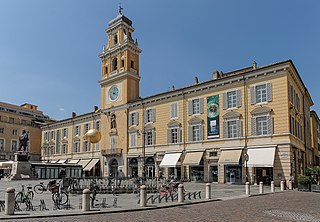
Parma is a city in the northern Italian region of Emilia-Romagna known for its architecture, music, art, prosciutto (ham), cheese and surrounding countryside. With a population of 198,292 inhabitants, Parma is the second most populous city in Emilia-Romagna after Bologna, the region's capital. The city is home to the University of Parma, one of the oldest universities in the world. Parma is divided into two parts by the stream of the same name. The district on the west side of the river is Oltretorrente. Parma's Etruscan name was adapted by Romans to describe the round shield called Parma.

The Ponte Vecchio is a medieval stone closed-spandrel segmental arch bridge over the Arno, in Florence, Italy. The only bridge in Florence spared from destruction during World War II, it is noted for the shops built along it; building shops on such bridges was once a common practice. Butchers, tanners, and farmers initially occupied the shops; the present tenants are jewellers, art dealers, and souvenir sellers. The Ponte Vecchio's two neighbouring bridges are the Ponte Santa Trinita and the Ponte alle Grazie.
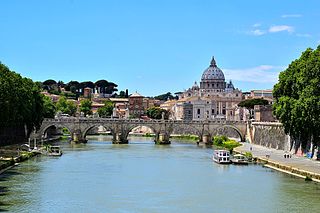
The Tiber is the third-longest river in Italy and the longest in Central Italy, rising in the Apennine Mountains in Emilia-Romagna and flowing 406 km (252 mi) through Tuscany, Umbria, and Lazio, where it is joined by the River Aniene, to the Tyrrhenian Sea, between Ostia and Fiumicino. It drains a basin estimated at 17,375 km2 (6,709 sq mi). The river has achieved lasting fame as the main watercourse of the city of Rome, which was founded on its eastern banks.
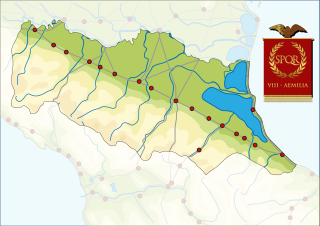
The Via Aemilia was a trunk Roman road in the north Italian plain, running from Ariminum (Rimini), on the Adriatic coast, to Placentia (Piacenza) on the River Padus (Po). It was completed in 187 BC. The Via Aemilia connected at Rimini with the Via Flaminia, which had been completed 33 years earlier, to Rome.

Trajan's Bridge, also called Bridge of Apollodorus over the Danube, was a Roman segmental arch bridge, the first bridge to be built over the lower Danube and considered one of the greatest achievements in Roman architecture. Though it was only functional for 165 years, it is often considered to have been the longest arch bridge in both total span and length for more than 1,000 years.

The Taro is a river in Emilia-Romagna, in northern Italy. It is a tributary of the Po and is 126 kilometres (78 mi) long. It flows almost entirely in the province of Parma, west of the city Parma. The Taro flows into the Po near Gramignazzo, a frazione of the comune of Sissa, north of Parma.

Sant'Angelo is the 11th rione of Rome, Italy, located in Municipio I. Often written as rione XI - Sant'Angelo, it has a coat of arms with an angel on a red background, holding a palm branch in its left hand. In another version, the angel holds a sword in its right hand and a scale in its left.

Collecchio is a town in the province of Parma, Emilia-Romagna, northern Italy. It is located 12.9 kilometres (8.0 mi) by road southwest of the centre of Parma. A major food-producing area, it is home to multinational Italian dairy and food corporation Parmalat and the Parma F.C. training complex, Centro Sportivo di Collecchio, and is connected by railway. Under the Romans the town was called Sustrina, Later, in Christian times it was called, Colliculum, because of its location on a small hill. In 2015, Collecchio became recognized as the first community to mandate that all fireworks set off in the town be silent.

Ponte Amerigo Vespucci is a bridge over the Arno River in Florence, Italy and named after Florence-born explorer Amerigo Vespucci. It joins the Lungarno Amerigo Vespucci to the Lungarno Soderini. To the east is the Ponte alla Carraia.
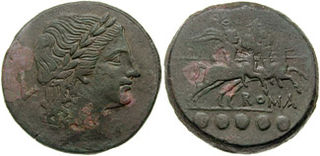
Luceria is an ancient city in the northern Apennines, located in the comune of Canossa in the Province of Reggio Emilia, on the right bank of the river Enza.

The Bridge of Tiberius, historically also the Bridge of Augustus or the Bridge of Saint Julian, is a Roman bridge in Rimini, in the region of Emilia-Romagna, northern Italy.

The Castel Vecchio Bridge or Scaliger Bridge is a fortified bridge in Verona, northern Italy, over the Adige River. The segmental arch bridge featured the world's largest span at the time of its construction.

The Ponte Vecchio or Ponte degli Alpini is the covered wooden designed by the architect Andrea Palladio in 1569. The bridge is located in Bassano del Grappa and was destroyed many times, the last time in World War II. The bridge spans the river Brenta.
The Ponte di Quintodecimo is a Roman stone bridge over the river Tronto next to the village of Quintodecimo, Marche, central Italy.

Ponte Sisto is a bridge in Rome's historic centre, spanning the river Tiber. It connects Via dei Pettinari in the Rione of Regola to Piazza Trilussa in Trastevere.
The Ponte San Lorenzo is a Roman bridge over the river Bacchiglione in Padua, Italy. Constructed between 47 and 30 BC, it is one of the very earliest segmental arched bridges in the world. It is also notable for the slenderness of its piers, unsurpassed in antiquity.

The Bridge of Augustus is a Roman arch bridge in the Italian city Narni in Umbria, built to carry the Flaminian Way over the river Nera. Of the original four spans of the 160-metre-long (520 ft) bridge, only the southernmost remains standing.

The Aqua Anio Vetus was an ancient Roman aqueduct, and the second oldest after the Aqua Appia.
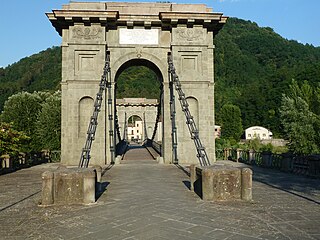
The Ponte delle Catene or Bridge of Chains is a 19th-century suspension bridge in Bagni di Lucca, Tuscany. The Bridge spans the river Lima, a branch of the Serchio, and links Fornoli and Chifenti.

The Admiral's Bridge is a medieval bridge of Palermo, located in Piazza Scaffa. It was built over the Oreto River during the era of the Norman Sicily by the ammiratus ammiratorum George of Antioch. In 2015, it became a UNESCO World Heritage Site as part of a series of nine civil and religious structures inscribed as Arab-Norman Palermo and the Cathedral Churches of Cefalù and Monreale.



















